
Geranium is a genus of 422 species of annual, biennial, and perennial plants that are commonly known as geraniums or cranesbills. They are found throughout the temperate regions of the world and the mountains of the tropics, but mostly in the eastern part of the Mediterranean region.

Geranium maderense, known as giant herb-Robert or the Madeira cranesbill, is a species of flowering plant in the family Geraniaceae, native to the island of Madeira. It is sometimes confused with another Madeira endemic, Geranium palmatum.

Geranium sanguineum, common names bloody crane's-bill or bloody geranium, is a species of hardy flowering herbaceous perennial plant in the cranesbill family Geraniaceae. It is also the county flower of Northumberland.

Geranium maculatum, the wild geranium, spotted geranium, or wood geranium, is a perennial plant native to woodland in eastern North America, from southern Manitoba and southwestern Quebec south to Alabama and Georgia and west to Oklahoma and South Dakota.

Geranium sylvaticum, the wood cranesbill or woodland geranium, is a species of hardy flowering plant in the family Geraniaceae, native to Europe and northern Turkey.

Geranium viscosissimum, commonly known as the sticky purple geranium, is a perennial in the flowering plant family Geraniaceae. It is thought to be a protocarnivorous plant.

Geranium lucidum, commonly known as shining cranesbill or shining geranium or shiny geranium, is a herbaceous annual plant of the genus Geranium. It is native to Europe, western Asia and North Africa. It has been introduced to North America as a garden plant and in places, particularly the Pacific Northwest, has become naturalised and is viewed as an invasive species and noxious weed.

Gaultheria hispida, commonly known as the copperleaf snowberry, is an endemic eudicot of Tasmania, Australia. It is an erect multi-branched shrub, that can be found in wet forests and alpine woodlands. Its berries appear snowy white and leaves are tipped with a copper tinge, hence the common name.

Pelargonium peltatum is a scrambling perennial plant with five shallow or deeply lobed, circular- to heart-shaped, somewhat fleshy leaves, sometimes with a differently coloured semicircular band, that has been assigned to the cranesbill family. It carries umbel-like inflorescences with 2–10, white to mauve, bilateral symmetrical flowers, each with a "spur" that is merged with the flower stalk. It is known by several common names including ivy-leaved pelargonium and cascading geranium. It is native to southern and eastern South Africa. In its home range, it flowers year round but most vigorously from August to October.

Geranium subcaulescens is a species of flowering plant in the geranium family Geraniaceae, that is native to Italy, Turkey and the Balkans. A low, mounded evergreen perennial, it typically grows to 8 in (20 cm) tall by more than 11 in (28 cm) broad, with grey-green orbicular and lobed leaves, and masses of bright magenta pink flowers with black centres in summer.
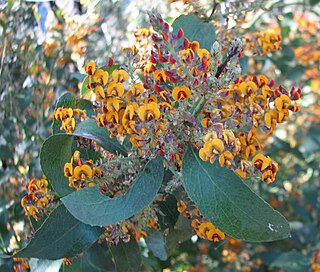
Daviesia latifolia, commonly known as hop bitter-pea, is a species of flowering plant in the family Fabaceae and is endemic to south-eastern Australia. It is a slender, erect, spreading shrub with elliptic, egg-shaped or lance-shaped phyllodes and orange-yellow and maroon flowers in long racemes.
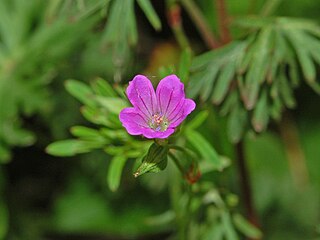
Geranium columbinum, common name long-stalked crane's-bill or longstalk cranesbill, is a herbaceous annual plant in the family Geraniaceae.

Geranium nodosum, the knotted crane's-bill, is a perennial herbaceous plant in the family Geraniaceae.
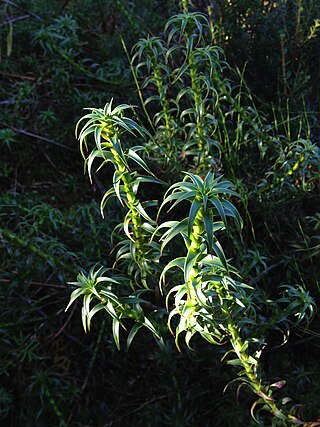
Richea gunnii, the bog candleheath or Gunns richea, is an endemic Tasmanian angiosperm. It is a dicot of the family Ericaceae and is found in Central, Western and North-east Tasmania.

Cotula alpina, also known as the alpine cotula, is a perennial herb in the family Asteraceae. It is a small flowering plant that forms ground covering mats and is well adapted to alpine environments.
Monotoca glauca, known as goldy wood, is a heath family shrub endemic to Tasmania, Australia and is one of 17 described Monotoca species. It is a widespread and abundant understory species found on the margins of wet eucalypt forests and logged areas.
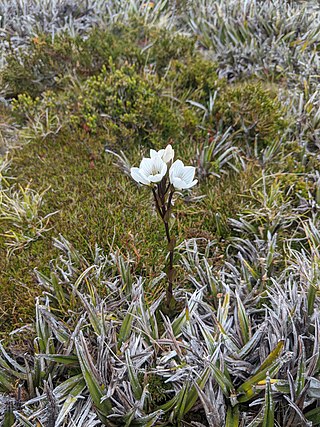
Chionogentias diemensis is a flowering herbaceous alpine plant in the family Gentianaceae, endemic to the island of Tasmania in Australia. It is commonly known as the Tasmanian mountain gentian. Chionogentias diemensis has been classified into two sub-species: the Tasmanian snow-gentian and the Ben Lomond snow-gentian.
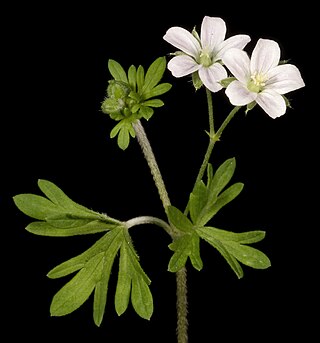
Geranium solanderi is a species of plant in the family Geraniaceae. It is native to Australia, and to New Zealand.

Coprosma moorei, commonly known as blue matcurrant or turquoise coprosma, is a small, mat forming, prostrate shrub in the Rubiaceae family. It is native to highland areas of Tasmania and Eastern Victoria.
Celmisia saxifraga, commonly known as the small snowdaisy, is a perennial herb in the Asteraceae family. It is native to Tasmania and Victoria, where it grows in alpine grasslands above the snowline.





















